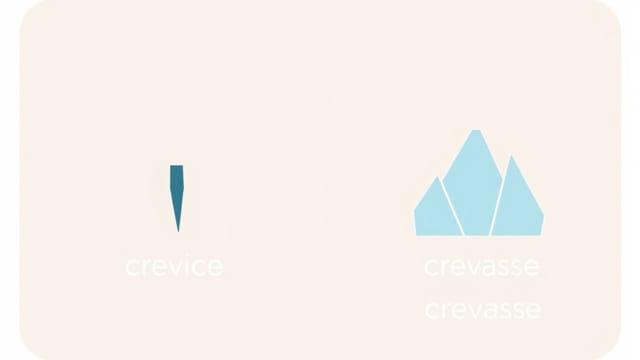In English, some words look very similar yet are pronounced and used differently. A common example is crevice and crevasse. These two words can be confusing not only because of their spelling but also because of their pronunciation and meaning. If you’re learning English or want to improve your pronunciation skills, knowing the correct way to say crevice and crevasse is important. Many native speakers even mix them up at times, especially in casual conversations or when describing geographical features. Let’s dive into how to pronounce each word correctly and understand the key differences.
Understanding the Basics of Pronunciation
Pronunciation in English often varies based on word origin, stress patterns, and regional accents. Some English words derived from French, like crevasse, retain elements of French pronunciation, which can make them tricky for learners. Meanwhile, crevice is more anglicized and straightforward for English speakers. Let’s explore each word individually before comparing them directly.
How to Pronounce Crevice
The word crevice is pronounced asKREV-iss. It has two syllables:
- First syllable: KREV rhymes with rev or lev.
- Second syllable: iss sounds like the word is.
The stress is on the first syllable:KREV-iss. This word is fully anglicized and is commonly used in day-to-day English.
How to Pronounce Crevasse
The word crevasse is pronounced askrə-VASSorkruh-VASS. It also has two syllables:
- First syllable: kruh pronounced with a soft and unstressed schwa sound.
- Second syllable: VASS rhymes with mass and carries the stress.
Notice that the stress is on the second syllable: kruh-VASS. This word keeps more of its French influence in pronunciation and is considered more formal or technical in certain contexts, especially geography or mountaineering.
Differences Between Crevice and Crevasse
Now that we know how to pronounce each word correctly, let’s explore what they mean and how they differ in both usage and context. Understanding the definitions will also help reinforce correct pronunciation through context clues.
Definition of Crevice
A crevice refers to a narrow crack or opening, especially in a rock or wall. It’s usually small and not very deep. You might see a crevice in a brick wall, a cliff face, or between floorboards. It’s a common English word used in everyday conversation.
Example sentences:
- Water seeped into the crevice in the rock.
- She hid the key in a crevice behind the bookshelf.
Definition of Crevasse
A crevasse is a deep open crack, especially one found in a glacier or ice field. This term is more technical and is used mostly in scientific or geological contexts. A crevasse is often large, deep, and dangerous to fall into.
Example sentences:
- The climber narrowly avoided falling into the crevasse.
- Crevasses can be hidden under thin layers of snow, posing a serious risk.
Why Pronunciation Matters
Correct pronunciation of crevice vs crevasse is important not just for clarity but also for safety in some contexts. For example, if a mountaineer refers to a crevice instead of a crevasse, they may downplay the danger of a situation. Similarly, if someone says crevasse when talking about a small crack in the wall, it might sound overly dramatic or incorrect.
Tips to Master the Pronunciation
- Listen to Native Speakers: Use audio dictionaries or language apps to hear both words pronounced by native English speakers.
- Practice with Syllables: Break down the syllables and practice saying them slowly. For example, say KREV-iss slowly, then speed up.
- Use in Sentences: Practice using both words in context. This helps solidify the pronunciation and meaning together.
- Record Yourself: Hearing your own voice can help you compare and correct your pronunciation over time.
Common Confusions and Misuses
Because crevice and crevasse look so similar, people often use them interchangeably, which can lead to misunderstanding. However, as shown, their meanings and pronunciations are quite different. Below are a few common mix-ups:
- Mispronouncing crevasse as KREV-ass: This mistake puts the wrong stress and uses an anglicized vowel sound. Instead, remember it’s kruh-VASS.
- Using crevice to describe a glacier crack: This can mislead others, especially in scientific or outdoor settings.
- Overusing crevasse in casual settings: Saying crevasse when describing a small wall crack sounds exaggerated or humorous.
Crevice and Crevasse in Literature and Science
Both crevice and crevasse appear in literature and academic texts, though in different contexts. Crevice is more likely to appear in novels, especially descriptive writing. Meanwhile, crevasse is often found in scientific reports, particularly those dealing with geology, glaciology, or mountaineering.
For instance, in adventure stories set in the mountains, the term crevasse is used to describe a major hazard. In contrast, a haunted house story might refer to a mysterious crevice in the wall where light leaks through.
Helpful Mnemonic
To remember the difference, use this tip:
- Crevice= ice small like a slice
- Crevasse= ass bigger and deeper
While humorous, this can help language learners remember which word refers to the deeper and more dangerous opening.
Crevice vs Crevasse Pronunciation
In summary, though crevice and crevasse look similar, they have distinct pronunciations and meanings. Crevice is pronouncedKREV-issand refers to small cracks, while crevasse is pronouncedkruh-VASSand refers to large glacier fissures. Knowing how to pronounce and use them correctly will help improve both your spoken English and your understanding of context. It’s a small detail, but one that shows a deeper command of the language. With practice, you can confidently use both words in the right way and avoid common mix-ups.
